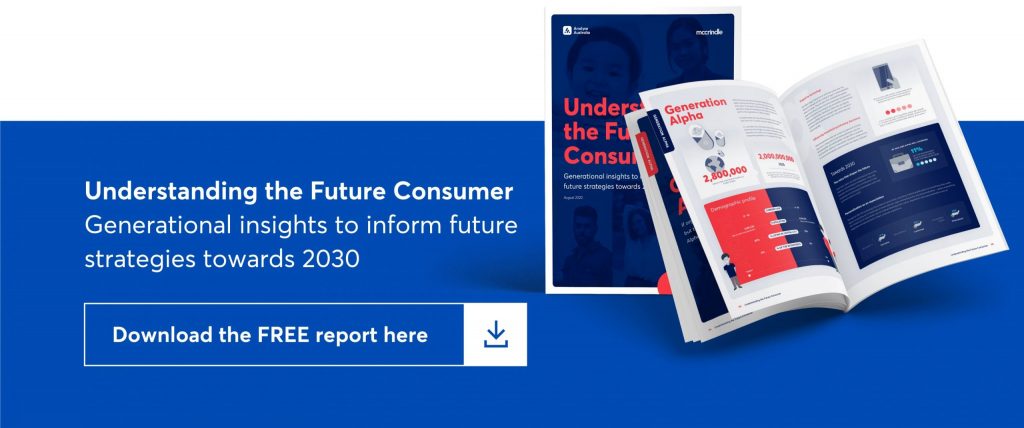By: McCrindle
While 2020 began with hope and optimism for a new year and decade, the COVID-19 pandemic quickly took hold of the world, and the subsequent lockdowns and restrictions having many personal impacts for people, but also on the economy. Despite a tough year in 2020, economists are positive about Australia’s recovery over the coming years.
Australia’s first recession in three decades
In the September quarter of 2020, the Australian economy experienced a growth of 3.3%, following two consecutive quarters of economic contraction. It also signifies the first recession that Australia has seen since 1991, when Australia recorded a 1.3% and 0.1% decline in GDP, as a result of the “recession that Australia had to have”. Since then, Australia has negated the seasonality of economic expansion and contraction again and again, floating above the Global Financial Crisis in the late 2000s, recording a dream 29-year-run of GDP growth.
Two generations of Australians (Generation Z and Generation Alpha) were born without ever living through the full effect of an economic recession – this being their first, with significant impacts on them and their future.
While a case can be made that the economic impacts of COVID-19 merely tipped over the already slowing economy, experts are anticipating a hopeful economic recovery regardless of the mechanism of the recession.
A hopeful outlook
Recent progress of vaccines and treatments have lifted expectations and contributed towards a number of positive indicators which spells an overall promising global economic outlook.
For a global pandemic that recorded its first million deaths in nine months, and the next million in just three, Australia has remained minimally affected relative to other countries. Case numbers and COVID-related deaths have remained low, a result of Australia’s public health measures, geography, climate, and the timeline of global infections.
It is precisely because of this that the 2021 Australian economic outlook is more positive than many other nations across the world. Estimated to close out 2020 with an annual GDP reduction of 4%, the 2021 economic outlook is one of growth.

The global recovery
The OECD’s December 2020 Economic Outlook forecasts a gradual global recovery that is partial and uneven. Acknowledging the considerable uncertainty with a fast-moving virus and varying pace of health interventions, the OECD’s baseline projection has global output returning to pre-COVID levels by the end of 2021.
China’s already rebounding economy is projected to continue with a projected GDP growth of 1.8% in 2020 and around 8% in 2021, a result of supportive fiscal policy and strong investment in real estate and infrastructure.
This is similar to that of India (7.9% growth in 2021), supporting demand through reduction of policy interest rates. It does, however, follow the large projected contraction of 9.9% in 2020.
Severely impacted by COVID-19, the United States is projected to record a 3.7% contraction in 2020 before rising by 3.2% in 2021.
Australia’s recovery
The assessment for Australia is a projected growth of 3.2% in 2021. While the unemployment rate will likely rise initially with the tapering of job retention schemes, it is projected to slowly decline. The impact of reducing fiscal policy support is also projected to be offset by recovery in private sector activity as virus containment restrictions further ease.
The Reserve Bank of Australia’s economic outlook is similar with the expectation that the GDP level of a number of major economies will remain below pre-COVID forecasts for a number of years. Also acknowledging the uncertainty that continues to surround the outlook, RBA projects GDP growth of around 5% over 2021 under their baseline scenario.
PwC’s January 2021 projections have made comparable observations, projecting that the global economy will revert to pre-COVID level of output by the end of 2021 or early 2022, underpinned by an uneven pattern of recovery across sectors, countries, and income level.
Similarly, Deloitte Access Economics projects a 2021 GDP growth of 4.4% for Australia based on the assumption that domestic restrictions gradually ease as vaccines roll out, and international borders re-open gradually to cover much of the world by the end of 2021.
Article supplied with thanks to McCrindle.
About the Author: McCrindle are a team of researchers and communications specialists who discover insights, and tell the story of Australians – what we do, and who we are.
Feature image: Photo by Laura Cros on Unsplash

